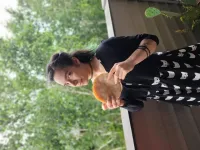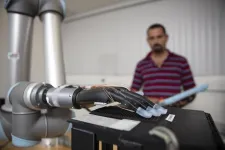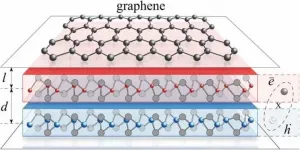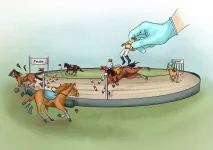Study reveals new aspects of gingivitis and body's response
Links to other health issues suggested
2021-07-14
(Press-News.org) UW researchers reveal new aspects of gum disease and body's protective response
SEATTLE - A team led by University of Washington researchers has, for the first time, identified and classified how different people respond to the accumulation of dental plaque, the sticky biofilm that gathers on teeth. Their work, recently published in the journal Proceedings of the National Academy of Sciences of the United States of America (PNAS), sheds important new light on why some people may be more prone to serious conditions that lead to tooth loss and other problems.
Left unchecked, plaque buildup can induce gingivitis, or gum inflammation. Gingivitis, in turn, can lead to periodontitis, a serious gum infection that damages the soft tissue and can destroy the bone that supports teeth. Not only can this result in tooth loss, but chronic inflammation can also spur other serious health consequences, including heart disease, diabetes, cancer, arthritis, and bowel diseases.
The researchers also found a previously unidentified range of inflammatory responses to bacterial accumulation in the mouth. When bacteria build up on tooth surfaces, it generates inflammation, a tool the body uses to tamp down the buildup. Previously, there were two known major oral inflammation phenotypes, or individual traits: a high or strong clinical response and a low clinical response. The team identified a third phenotype, which they called "slow": a delayed strong inflammatory response in the wake of the bacterial buildup.
The study revealed for the first time that subjects with low clinical response also demonstrated a low inflammatory response for a wide variety of inflammation signals. "Indeed, this study has revealed a heterogeneity in the inflammatory response to bacterial accumulation that has not been described previously," said Dr. Richard Darveau of the UW School of Dentistry, one of the study's authors.
His School of Dentistry colleague and study co-author Dr. Jeffrey McLean said, "We found a particular group of people that have a slower development of plaque as well as a distinct microbial community makeup prior to the start of the study." The study authors wrote that understanding the variations in gum inflammation could help better identify people at elevated risk of periodontitis. In addition, it is possible that this variation in the inflammatory response among the human population may be related to susceptibility to other chronic bacterial-associated inflammatory conditions such as inflammatory bowel disease.
In addition, the researchers found a novel protective response by the body, triggered by plaque accumulation, that can save tissue and bone during inflammation. This mechanism, which was apparent among all three phenotypes, utilizes white blood cells known as neutrophils. In the mouth, they act something like cops on the beat, patrolling and regulating the bacterial population to maintain a stable condition known as healthy homeostasis.
In this instance, plaque is not a villain. To the contrary, the researchers said that the proper amount and makeup of plaque supports normal tissue function. Studies in mice have also shown that plaque also provides a pathway for neutrophils to migrate from the bloodstream through the gum tissue and into the crevice between the teeth and gums.
When healthy homeostasis exists and everything is working right, the neutrophils promote colonization resistance, a low-level protective inflammatory response that helps the mouth fend off an excess of unhealthy bacteria and resist infection. At the same time, the neutrophils help ensure the proper microbial composition for normal periodontal bone and tissue function.
The researchers' findings underscore why dentists preach the virtues of regular brushing and flossing, which prevent too much plaque buildup. "The idea of oral hygiene is to in fact recolonize the tooth surface with appropriate bacteria that participate with the host inflammatory response to keep unwanted bacteria out," Dr. Darveau said. The bacteria start repopulating the mouth's surfaces spontaneously and almost immediately afterward, he said.
INFORMATION:
This research was part of a PhD thesis by Dr. Shatha Bamashmous, a clinician scientist in Dr. Darveau's laboratory, and was conducted by a team researchers that included Dr. McLean, co-communicating author and colleague in the UW School of Dentistry's Department of Periodontics; Dr. George Kotsakis of the University of Texas Health Science Center and formerly a UW Department of Periodontics member; Kristopher Kerns of the UW dental school's Department of Oral Health Sciences; Dr. Brian Leroux, a biostatistician with the school's Department of Oral Health Sciences; and Dr. Camille Zenobia, Dr. Dandan Chen, and Dr. Harsh Trivedi of the Colgate-Palmolive Company's Department of Oral Health Research.
[Attachments] See images for this press release:
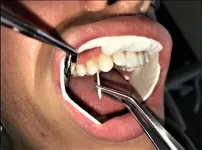
ELSE PRESS RELEASES FROM THIS DATE:
2021-07-14
CORVALLIS, Ore. - Oregon State University scientists are beginning to unravel the key microorganisms that contribute to the fermentation of kombucha, research that is already aiding large-scale kombucha producers in the fast-growing industry.
Kombucha is a fermented tea drink that has been homebrewed around the world for centuries, but in recent years has become widely popular with a global market size expected to grow from $1.3 billion in 2019 to $8.1 billion by 2027, according to an industry report. Several large producers, including Humm and Brew Dr., are based in Oregon.
Kombucha is produced by fermenting sugared tea using a symbiotic culture of bacteria and yeast, commonly referred to as SCOBY, and adding flavorings to enhance the taste. But ...
2021-07-14
Vaccine skepticism among young adults may stall efforts to achieve herd immunity - a threshold in which approximately 80 percent of a population is vaccinated against the coronavirus.
A study by UC San Francisco researchers found that about one in four unvaccinated people aged 18 to 25 said that they "probably will not" or "definitely will not" get the COVID-19 vaccination, despite the fact that this demographic has been found to be more likely than other age-groups to transmit coronavirus, jeopardizing the health of older unvaccinated adults and facilitating ...
2021-07-14
Each fingertip has more than 3,000 touch receptors, which largely respond to pressure. Humans rely heavily on sensation in their fingertips when manipulating an object. The lack of this sensation presents a unique challenge for individuals with upper limb amputations. While there are several high-tech, dexterous prosthetics available today - they all lack the sensation of "touch." The absence of this sensory feedback results in objects inadvertently being dropped or crushed by a prosthetic hand.
To enable a more natural feeling prosthetic hand interface, researchers from Florida Atlantic University's ...
2021-07-14
New data on macaw movements gathered by the Texas A&M University College of Veterinary Medicine & Biomedical Sciences' (CVMBS) The Macaw Society has the potential to greatly improve conservation strategies for the scarlet macaw, as well as similar species of large parrots.
While the overall conservation status of the scarlet macaw is listed as "least concern" by the International Union for Conservation of Nature, the species is declining across much of Central America and in other parts of its range in South America. The species also shares its habitat with numerous endangered species and influences the ecosystems in which ...
2021-07-14
The concept of interoperability describes the ability of different systems to communicate. This is a major challenge in biomedical research, and in particular, in the field of personalised medicine, which is largely based on the compilation and analysis of numerous datasets. For instance, the COVID-19 pandemic has shown that even when the technical, legal and ethical constraints are lifted, the data remain difficult to analyse because of semantic ambiguities. Under the auspices of the Swiss Personalized Health Network (SPHN) and in close collaboration with representatives from all five Swiss university ...
2021-07-14
Superconductivity is a physical phenomenon where the electrical resistance of a material drops to zero under a certain critical temperature. Bardeen-Cooper-Schrieffer (BCS) theory is a well-established explanation that describes superconductivity in most materials. It states that Cooper pairs of electrons are formed in the lattice under sufficiently low temperature and that BCS superconductivity arises from their condensation. While graphene itself is an excellent conductor of electricity, it does not exhibit BCS superconductivity due to the suppression of electron-phonon interactions. This is also the reason that most 'good' conductors such as gold and copper are 'bad' ...
2021-07-14
The corona pandemic has ensured that the term "mRNA" is now also known to a large public beyond laboratories and lecture halls. However, the molecule is much more than an important component of a successful vaccine against the SARS-CoV-2 virus. "mRNAs are a central component of all living things on our planet. Without them life as we know it would not function," says Elmar Wolf.
Wolf is a professor for tumour system biology at the Department of Biochemistry and Molecular Biology at the University of Würzburg. With his research team, he has now deciphered new details about the formation of mRNA which provide novel insights into how a fundamental process inside cells works: the transcription. The team ...
2021-07-14
A team of researchers, affiliated with UNIST has succeeded in developing a new optical microscope technology, capable of deeper imaging beyond the biological tissues. This breakthrough has been led by Professor Jung-Hoon Park and his research team in the Department of Biomedical Engineering at UNIST.
Optical imaging technology has emerged as an essential research tool for biomedical studies due to its high resolution and good tomography capability. However, the limited penetration depth of the optical microscope makes it difficult to observe biological tissues of more than 100 μm thickness. This is because strong light scattering, caused by various components ...
2021-07-14
New York, NY--July 13, 2021--The past decade has witnessed scandal after scandal over private images maliciously or accidentally made public. A new study from computer scientists at Columbia Engineering reveals what may be the first way to encrypt personal images on popular cloud photo services, such as those from Google, Apple, Flickr and others, all without requiring any changes to -- or trust in -- those services.
Smartphones now make it easy for virtually everyone to snap photos, with market research firm InfoTrends estimating that people now take more than a trillion photos each year. The limited ...
2021-07-14
A new study reveals the strategies that stop bandits from illegally fishing in Australian waters--but warns there is a cost to the region's poorer countries.
Co-author Dr Brock Bergseth, from the ARC Centre of Excellence for Coral Reef Studies at James Cook University, said poachers are simply following the recurring history of human fishing: intensively fish and devastate local resources, then move further afield to--in these cases--fish illegally or poach in other countries' waters.
"Millions of people rely on fish and seafood and when offered no alternative choice, will chose banditry and illegal fishing ...
LAST 30 PRESS RELEASES:
[Press-News.org] Study reveals new aspects of gingivitis and body's response
Links to other health issues suggested

